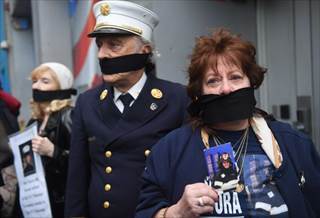By Joseph Stepansky, Erik Badia, Larry Mcshane New York Daily News

Firefighters stand at attention Saturday as emergency vehicles transporting the unidentified remains of victims of the 9/11 attack to the new World Trade Center site, where they will be kept beneath the museum. Andrew Burton/Getty Images
The long-unidentified remains of missing World Trade Center victims returned to Ground Zero in a solemn Saturday ceremony that left 9/11 family members bitterly divided.
The early-morning relocation from the city medical examiner’s office to a space in the bedrock 70 feet below infuriated some relatives who felt the new location was a slap in the face.
A dozen protesters wore strips of black cloth across their mouths and later raged that the remains of 1,115 unidentified victims deserved a better fate than sitting beneath the National September 11 Memorial & Museum.
“That’s a disgrace — a national disgrace,” said retired Deputy Fire Chief Jim Riches, whose firefighter son Jimmy died in the terrorist attack.
“We would like to see remains moved above ground in a repository akin to the tomb of the unknowns,” said Riches, referring to the burial site in Arlington National Cemetery. “On the plaza, to add a little respect and dignity.”

Images Relatives of 9/11 victims stage a protest. One family member said it was a ‘national disgrace.’ Emmanuel Dunand/AFP/Getty
A motorcade of four NYPD motorcycles and a police emergency-services truck, a fire engine, three Port Authority vehicles and three unmarked SUVs made the 5-mile trip on a foggy morning. The fire engine, along with the NYPD and PA trucks, each carried a coffin-sized military transfer case to the site where the twin towers once rose 110 stories above the city.No sirens sounded as the grim cortege wound its way silently through Manhattan, carrying nearly 8,000 vacuum-sealed pouches of remains.
The flag-draped cases were then removed from the vehicles and carried through the plaza outside the 9/11 museum as construction workers around the new 1 World Trade Center paused.
Ten firefighters stood and saluted as the remains were brought past family members — the only people allowed in the plaza for the understated ceremony that began shortly after 7 a.m.
“It was very respectful,” said Rose Foti, whose firefighter son Robert was among the 2,753 casualties. “The police and firemen lined up. They brought three coffins in. Everyone was silent. Then they brought them down the stairs.”
FDNY Lt. James McCaffrey, whose firefighter brother-in-law Orio Palmer died on the 78th floor of the south tower, echoed Riches’ call for a ground-level tomb.
“The decision to put the human remains of the 9/11 dead in this basement is inherently disrespectful and totally offensive,” McCaffrey said. “The human remains of the 9/11 dead do not deserve a place of prominence equal to that of the much heralded trees and waterfalls?” he asked rhetorically. “We think they do.”
McCaffrey also questioned why the procession took place so early in the day.
“I think they did it intentionally,” he said. “We believe that they didn’t want the fact that there is still a great deal of opposition to this plan to be seen or heard. If they were so enamored with this reverential procession and transfer, wouldn’t they have done it in the middle of the day?”
Some of the relatives clutched photos of the lost, while others raised signs denouncing the transfer.
But not all the relatives shared the protesters’ outrage at the long-anticipated move.
Charles G. Wolf, whose wife Katherine was killed, was among those hailing the decision to return the unidentified victims to the place where they perished more than a dozen years ago.
“We have this beautiful memorial, and we all asked for the remains to come back to sacred bedrock,” Wolf said. “Until you find out who they are, and the family accepts those remains, where are you going to put them?”
Wolf was a member of the family advisory council that suggested relocating the remains in 2003.
Monica Iken-Murphy never received any remains of her husband Michael, a bond broker who worked on the 84th floor of the south tower.
She thinks the transfer of the fragmentary remains was absolutely the right move.
“These are human remains, and they’re going back home,” said Iken-Murphy. “They’re together. And it’s nice to know that maybe in the next five years, I might find out if Michael’s there.”
The medical examiner will retain access to the remains in hopes that advances in technology can help with identification.
Iken-Murphy thought the ceremony surrounding the transfer of the remains was handled beautifully.
“It was very reverent and respectful,” she said. “It was done in a meaningful way. It was really nice to be a witness to it.”
But opponent Sally Regenhard said she was incensed by the decision to place the remains inside the museum.
“We want a proper memorialization of the dead,” said Regenhard, mother of late FDNY member Christian Regenhard.
“We’re here because it’s an atrocity to put human remains of heroes and victims in a museum.”

